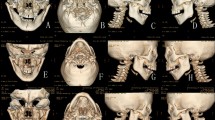Abstract
Introduction
Since the advent of rigid fixation, there has been a paradigm shift in the management of condylar fractures from closed treatment options to open reduction and rigid internal fixation.
Materials and Method
Sixty-eight cases of condylar fractures reporting to Vydehi Institute of Dental Sciences, Bangalore, between 2009 and 2018 were reviewed in terms of age, sex, type of fracture, position of the mandibular third molar and the treatment rendered.
Results
The majority of the patients were males (60). There was an involvement of the right side in 34, left in 21 and bilateral involvement in 13 cases. Forty-three of the fractures were subcondylar, and 25 were intracapsular. Significantly in most cases, the mandibular third molar was either fully erupted (42) or missing (12). Sixty-one cases were subjected to surgical management including 49 cases of rigid internal fixation, and 12 of the intracapsular fractures had the condylar stump/segment removed. Only seven cases were not treated surgically. Most of the cases (44) were in the age group of 21–40, 12 were in the age group of 41–60, 9 were in the age group of 1–20, and 3 patients were above 60.
Conclusion
Condylar fractures more often do not require surgical intervention, and their incidence is more likely to occur when the third molar is either fully erupted or missing.







Similar content being viewed by others
References
Chrcanovic BR (2012) Factors influencing the incidence of maxillofacial fractures. Oral Maxillofac Surg 16:3–17
Chrcanovic BR, Abreu MH, Freire-Maia B, Souza LN (2012) 1454 mandibular fractures: a 3- year study in a hospital in Belo Horizonte, Brazil. J Craniomaxillofac Surg 40:116–123
Chrcanovic BR (2012) Open versus closed reduction: mandibular condylar fractures in children. Oral Maxillofac Surg 16:245–255
Posnick JC, Wells M, Pron GE (1993) Pediatric facial fractures: evolving patterns of treatment. J Oral Maxillofac Surg 51:836–844 (discussion 844–5)
Ying BB, Zhang QQ, Zhu SS, Li YF (2018) Outcomes of treatment for intracapsular fractures of the mandibular condyle: recommendation for a new classification. Br J Oral Maxillofac Surg 56:139–143
Ellis E III, Throckmorton GS, Palmieri C (2000) Open treatment of condylar process fractures: assessment of adequacy of repositioning and maintenance of stability. J Oral Maxillofac Surg 58:27–34 (discussion 35)
Rozeboom L, Dubois R, Bos R, de Spijker J (2017) Lange: open treatment of unilateral mandibular condyle fractures in adults: a systematic review. Int J Oral Maxillofac Surg 46:1257–1266
Sforza Chiarella, Ugolini Alessandro, Sozzi Davide, Galante Domenico, Mapelli Andrea, Bozzetti Alberto (2011) Three-dimensional mandibular motion after closed and open reduction of unilateral mandibular condylar process fractures. J Craniomaxillofac Surg 39:249–255
Hlawitschka M, Loukota R, Echelt U (2005) Functional and radiological results of open and closed treatment of intracapsular (diacapitular) condylar fractures of the mandible. Int J Oral Maxillofac Surg 34:597
Tominaga K, Habu M, Khanal A, Mimori Y, Yoshioka I, Fukuda J (2006) Biomechanical evaluation of different types of rigid internal fixation techniques for subcondylar fractures. J Oral Maxillofac Surg 64:1510–1516
Ellis E III, Dean J (1993) Rigid fixation of mandibular condyle fractures. Oral Surg Oral Med Oral Pathol 76:6–15
Throckmorton GS, Dechow PC (1994) In vitro strain measurements in the condylar process of the human mandible. Arch Oral Biol 39:853–867
Meyer C, Kahn JL, Boutemi P, Wilk A (2002) Photoelastic analysis of bone deformation in the region of the mandibular condyle during mastication. J Craniomaxillofac Surg 30:160–169
Choi BH, Kim KN, Kim HJ, Kim MK (1999) Evaluation of condylar neck fracture plating techniques. J Craniomaxillofac Surg 27:109–112
Parascandolo Salvatore, Spinzia Alessia, Parascandolo Stefano, Piombino Pasquale, Califano Luigi (2010) Two load sharing plates fixation in mandibular condylar fractures: biomechanical basis. J Craniomaxillofac Surg 38(385):390
Rozeboom AVJ, Dubois L, Bos RRM, Spijker R, de Lange J (2018) Open treatment of condylar fractures via extraoral approaches: a review of complications. J Cranio-Maxillo-Fac Surg 46:1232–1240
He Dongmei, Yang Chi, Chen Minjie, Jiang Bin, Wang Baoli (2009) Intracapsular condylar fracture of the mandible: our classification and open treatment experience. J Oral Maxillofac Surg 67:1672–1679
Neff A, Kolk A, Deppe H et al (1999) New aspects for indications of surgical management of intra-articular and high temporomandibular dislocation fractures. Mund Kiefer Gesichtschir 3:24–29
Gaddipati R, Ramisetty S, Vura N, Kanduri RR, Gunda VK (2014) Impacted mandibular third molars and their influence on mandibular angle and condyle fractures: A retrospective study. J Cranio-Maxillo-Fac Surg 42:1102–1105
Zhu SJ, Choi BH, Kim HJ, Park WS, Huh JY, Jung JH et al (2005) Relationship between the presence of unerupted mandibular third molars and fractures of the mandibular condyle. Int J Oral Maxillofac Surg 34:382–385
Author information
Authors and Affiliations
Corresponding author
Ethics declarations
Conflict of interest
The authors declare that they have no conflict of interest.
Ethical Approval
All procedures performed in this retrospective study involving human participants were in accordance with the ethical standards of the institutional and with the 1964 Helsinki Declaration and its later amendments or comparable ethical standards.
Additional information
Publisher's Note
Springer Nature remains neutral with regard to jurisdictional claims in published maps and institutional affiliations.
Rights and permissions
About this article
Cite this article
Menon, S., Kumar, V., Archana, S. et al. A Retrospective Study of Condylar Fracture Management in a Tertiary Care Hospital—A 10-Year Experience. J. Maxillofac. Oral Surg. 19, 380–386 (2020). https://doi.org/10.1007/s12663-019-01257-2
Received:
Accepted:
Published:
Issue Date:
DOI: https://doi.org/10.1007/s12663-019-01257-2




